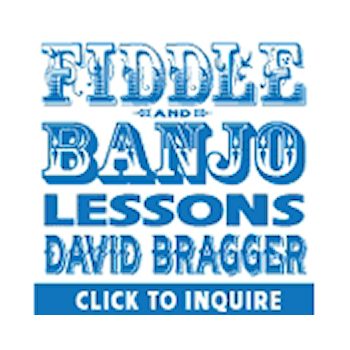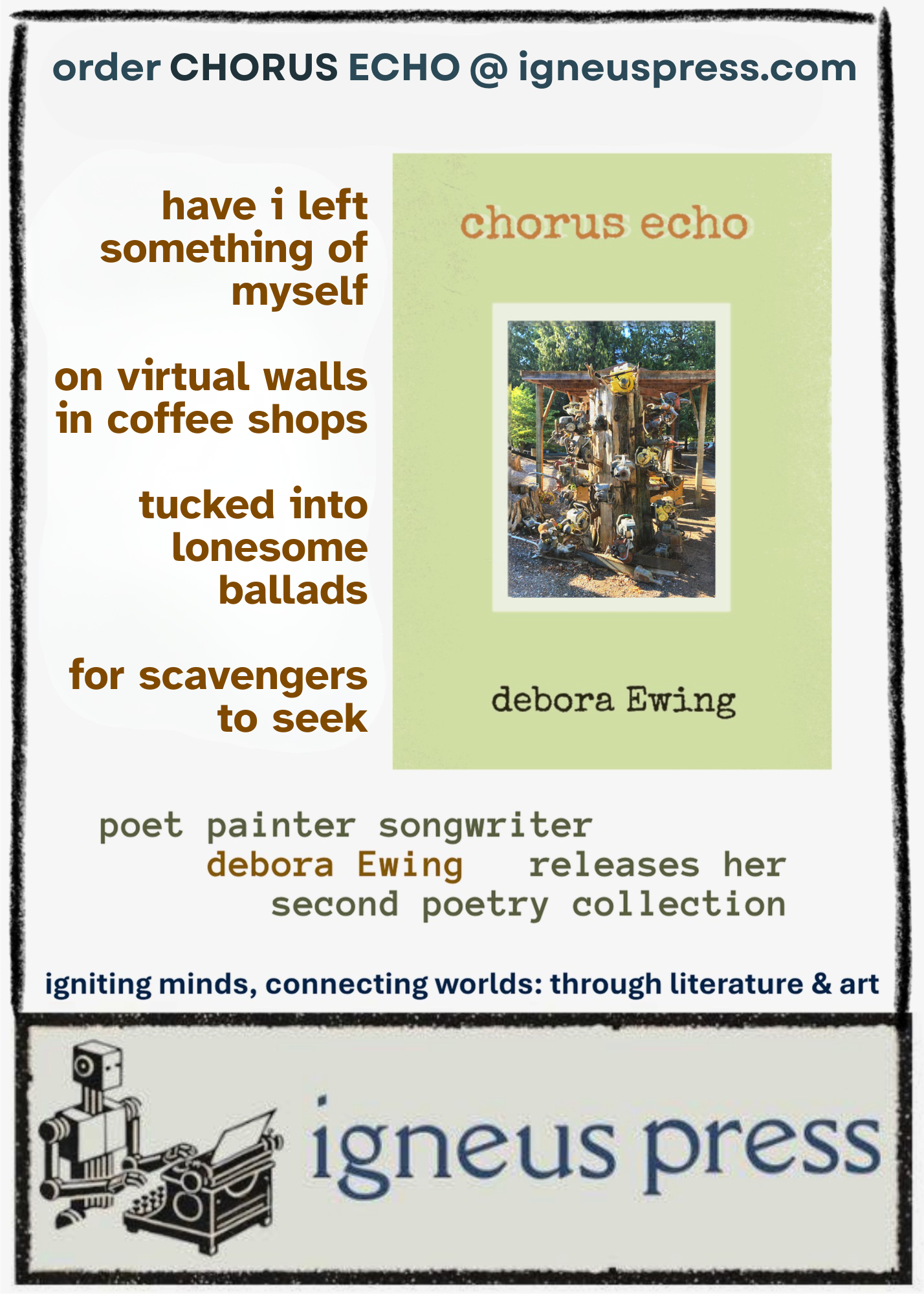Some Words with James Lee Stanley
Tehachapi's Renaissance Man
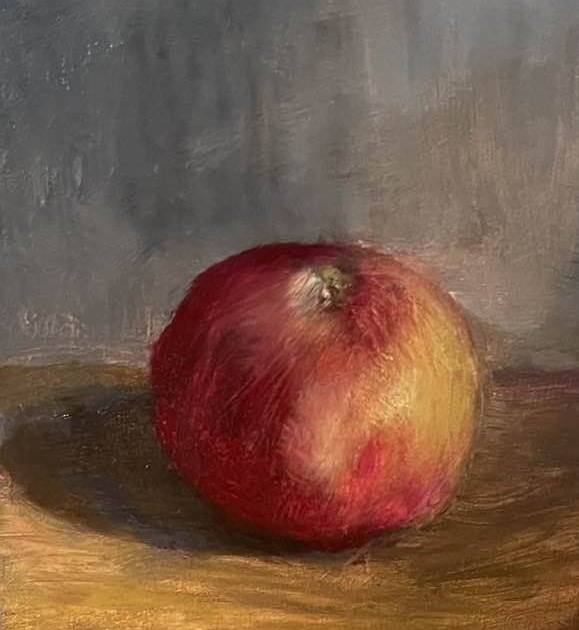
Apple, by James Lee Stanley
James Lee Stanley is perhaps best known for his “All Wood” series of albums: collaborative acoustic reimaginations of classic rock bands, like All Wood and Stones with John Batdorf or All Wood and Doors with Cliff Eberhardt. My personal favorite is All Wood and Led: a collection of Led Zeppelin songs chosen by Dan Navarro.
“I listened to (all the songs) once, and then I never listened to them again,” says James. You never imagined “Rock and Roll” like this.
Actually, JLS is best known for being a really great guy. That’s what people will tell you. He has 37 albums under his belt, most recently The Day Today, what people are referring to as James Lee’s “White Album.” His website rambles from deep philosophy to Deep Space 9, satisfying for a curious mind to discover. As you’re about to learn, he’s proficient in just about anything chooses to undertake. This time it was oil painting.
Me: So what made you decide this painting class was the thing you needed to do right now?
JLS: Well, to tell you the truth, my wife publishes Tehachapi Living Magazine here In Bear Valley Springs, and she interviewed this woman, Pam Phillips. I saw some of her artwork. Her artwork was unbelievable. I mean, she has Old Master technique. And I found out she lives like a half a mile up the road and offered lessons. I just thought it would be fun – I’m not interested in being a realist painter, but I really needed something that would get me out of thinking about the orange turd and the apartheid mofo from South Africa who’s trying to screw our entire world. And I mostly admit for three hours a week while I’m painting, I don’t think about that son of a bitch.
me: It seems to make sense that you’d go for painting because of your philosophy: Practicing one thing is practicing everything. Do you find that applies to the painting?
JLS: You know what? Yeah. I think that once you allow your creative juices to flow… I think that most people are discouraged from letting their creative juices flow, and I was always blessed to be encouraged in any direction. So I’m not afraid to try something and I’m not afraid to be bad at it.
me: I think there’s benefit to being bad at something. I highly encourage people to just retain one thing you’re really bad at that you enjoy doing. For me, it’s shooting pool. I’m terrible, but it’s fun.
JLS: Yeah, me too.
Me: I think that, like you’re saying – you were looking for some respite from your mind and frustration with the current situation – I think taking on something that you haven’t done before is a really great way to go about that.
JLS: Well, I’ve actually always been artistic. I’ve always drawn and painted; on my website, I think there’s a page of just sketches that I’ve done. I never did oils before, but I painted in watercolors and I have a plein air kit that I use sometimes and do acrylic.
When I was a kid, I thought I was going to leave Pennsylvania and go work for Walt Disney and draw for him, because even as a 10-year-old, I could draw exact replicas of all of the cartoon characters. So I’ve always had that thing. But then when I was 12, my uncle gave me a ukulele and I found that I fell right into it. And I got a guitar at 14 and now I’m 78, so we’re talking 64 years of playing the guitar, and I play it every day for a couple of hours. I really love it.
Me: That is excellent. How often do you draw still?
JLS: I have a sketch pad in the car, and I carry one when I’m on the road, when I’m flying anywhere. And I study Spanish for an hour a day. So frequently, when I get to the airports, I just do Spanish lessons while waiting to get on the plane, but I do like to sketch. I’ve just been doing all this stuff for years. I’ve done wood carving, and I’m also a really good carpenter. I built the garden shed on our house.
I’m not afraid to try anything. I’ve noticed that if I do it slowly enough, I can do anything that anybody’s ever done. I mean, a real carpenter could have put that garden shed together probably in a day or two. It took me about three weeks. I had to measure six times and make sure everything was right, you know what I mean? I just go really slowly when I don’t know how to do it.
Me: You’re paying attention to the details.
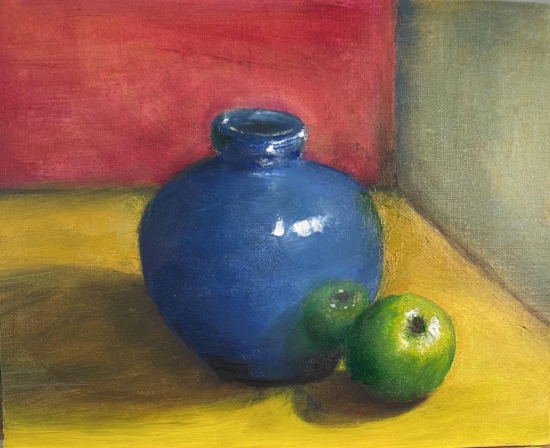
Blue Vase with Apple, by James Lee Stanley
JLS: And to get back to painting, dig this: That painting that you saw was after the first lesson. She said, “paint this apple.” So I looked at the apple, then just went to the canvas and painted an apple.
She came over and she said, “Well, James, that’s interesting, but it doesn’t look anything like the apple that I put in front of you.”
And I looked, and I realized I didn’t even try to capture the apple. I just looked at it, said it’s an apple, and then I drew one. You know what I mean?
She said, “You have to look at the subject more than you look at the painting.” So I started noticing the proportions: where the shadow was on the apple and where the light was. I just slowed down the way I looked at it, and I’m telling you, inside of an hour, it was an epiphany because I painted that apple and it looks terrific.
Me: It does look terrific. I really enjoy just looking at that apple. It’s got character.
JLS: Yeah, it does. I was thinking, I want to paint interesting things. I don’t want to paint an apple. And then I realized that what still life is, is it’s an exercise in observation and control and chiaroscuro. It doesn’t matter what you paint, what you’re trying to do is learn to observe and then translate that observation onto a canvas.
CHIAROSCURO
Me: You caught me at chiaroscuro. I like to think of light and dark as a vocabulary, in the way they interact.
JLS: It is, most definitely.
Me: There are messages in there, and those are the things that I try to capture in scratchboard, which is straight up black and white. It’s something like a sculpting process.
JLS: It’s also very unforgiving. I’ve done that. The thing I like about oil is that it’s really forgiving.
(me, in my mind: I did not expect to hear that.)
Me: I’m afraid of oil painting. The few times I’ve worked with oil, I ended up with that color you get when you mix all your Play-Doh together. I like acrylic because acrylic is forgiving. You can wash it off and do it again.
JLS: But that’s the same thing with oil. When I painted this apple, I realized I had the wrong shape. I simply took a cloth and I rubbed away what’s wrong with the apple, down to the canvas, and I started again. Also use my fingers a lot, to smear it around. And I don’t know, I thought it was much easier than acrylics. They dry so fast.
Me: I want to look at the apple again. Some of the texture seems to have been created from… maybe the brush?
JLS: Definitely. I used the brush, and I told you – she’s a realist. She wanted me to keep painting it until it looked like a photograph. I said, “I’ll tell you the truth. I’m here to learn how you blend colors and how you observe light and darkness, but I think this painting is done. The way it looks right now is the way I like it to look, so I’m just going to stop.”
And she said okay.
Me: That’s a special talent in art, knowing when it’s time to stop. I had a conversation with a fellow painter who says, “You need the shoulder guy – your friend that taps you on the shoulder and says, just stop screwing with it.”
JLS: You know what Picasso says? “Genius is the person behind you that stops you from putting the finishing touches on.”
The trick with painting – what makes you unique and individual as a painter – is this: You look at something that’s in three dimensions, then you take it into you and change it into two dimensions. Your style shows up. You see what I mean? Your uniqueness shows up in the way you’ve changed three dimensions to two dimensions.
Me: Oh, you’re the filter. So what’s the human filter doing when you compose a piece of music?
JLS: Regarding music, I believe we all resonate with the music we heard as we grew from infancy to our teens. At that point, our peers inform which music we think is cool. After we leave that teenage cage, we start to gravitate towards the music that resonates for us. And that music informs what we create as song writers – that is our filter.
When i was coming up, a new song writer would be assessed on what they had to say. If they had nothing to say, we wouldn’t care. Consequently, all my songs, regardless of how catchy the chorus might be, always have some serious meat to chew on intellectually.
me: What’s the human filter doing when the medium is photography?
JLS: With regard to photography, I believe your filters are informed by your sense of symmetry and chiaroscuro. When you take a photograph, the camera turns it into two dimensions, so it doesn’t go through you to turn into two dimensions. Whenever I do photography, I try to essentially crop it as I take it, but frequently do more cropping experiments to see what impacts me the most. It’s all trial and error. You keep doing it until it works for you. There are no mistakes, just a variety of paths until you find the one that resonates for you. That’s what gives you your uniqueness. Even when I hear a song I love and think, “I’m going to write one like that!” it never comes out like the inspiration. It always ends up sounding like me.

Boats, by James Lee Stanley
me: You have some sketches on your website. I really like the boats.
Yeah, I worked a long time on that. I think I have about four drawings of that where the boats aren’t right, where the perspective is weird. It took me a while to get that, and these were just people that I saw when I was in Eindhoven, which is in Holland. I was just sitting in a café and there were people there, so I started sketching them.
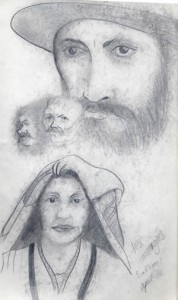
Turkish immigrants in Eindhoven, James Lee Stanley
Me: I keep trying to just draw one little thing every day. These days I do often work from pictures, because I have to. I’ve chosen an end result, rather than capturing what’s in front of me.
PAREIDOLIA
JLS: Tell me, debora, do you find that if you look at anything, I mean, just staring at some pillows on the sofa here, and I realize that between the shadows and the light, I can always see faces.
When I’m talking on the phone or something, I just make sketches lines, and then I look to see what’s in there, and then I bring that out. What I wanted to do was take lessons from this woman, learn how to really control oil, and then I thought it would be fun to sketch in oil. I mean, just go on a canvas and do a bunch of lines and then see what faces are in there and what things are in there and just bring them out. With that kind of control that I had for the apple, that’s actually what I’m looking forward to doing it. That’s why I took the lessons now.
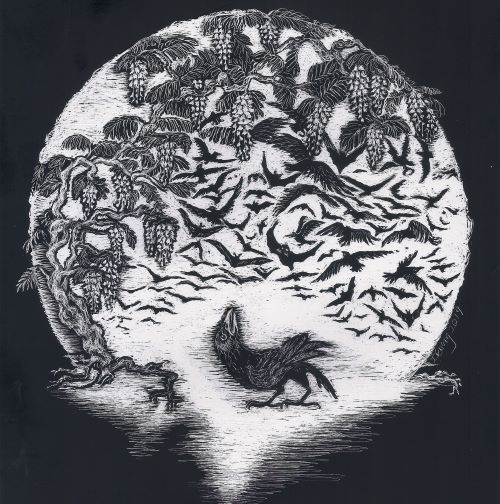
The Crow In Bat Country, by debora Ewing
Me: I’m always seeing a pattern. Pareidolia is what you call the occurrence of seeing faces or seeing something else in what you’re looking at, and that’s where a lot of my art comes from. I’ve got, you know what, hang on. (I get out Crow in Bat Country)
So the thing I wanted to show you is this: Scratchboard.
JLS: Oh, wow. Fabulous.
me: Thank you. The inspiration for that was a pattern of coffee grounds in the bottom of my mug.
JLS: I believe you.
VALENCE
me: In reading your older website, DATAMUSICATA, the thing (other than the apple) that’s been bugging me all week is your use of the word “valence.”
JLS: Valence? Plus and minus?
me (reading from the website): This is a section called “Procrastination, the old Crack.” And you wrote: “Just finished a conversation with a friend of mine who had some work. She just didn’t feel like doing her expense reports that when turned in would get her a substantial refund on all the cash she’s laid out for her business expenses. I asked her what the problem was, and she said that she didn’t feel like doing it. And then here’s the sentence. What universe exists where that has any valence whatsoever?” V-A-L-E-N-C-E.
JLS: Right. Accounting – or pluses and minuses, a plus balance or a minus balance.
me: I’m just not used to that word being used that way. I’m thinking in grammar: how many other parts of a sentence the verb needs to complete its meaning, subject/object and whatnot.
JLS: I could have used the word value. I think when people use the phrase, “I didn’t feel like it,” I’m always astounded. It’s like when they use the word “should.” I don’t even know why we have the word “should” because it doesn’t really have any impact. It doesn’t exist anywhere. If something has to be done, I can tell you the best time to do it. As soon as you realize it has to be done, get off your ass and do it, and then it’s done. You don’t have it hanging over.
Me: I learned a useful tip recently. Look at the thing. Is this going to take more than five minutes to do? No? Then just do it. Just do it right now. And then it’s done.
JLS: I heard Cher giving advice to somebody on television, and she said, “Is this going to matter in five years? And if it isn’t going to matter in five years, then the hell with it.”
JLS: Something else just occurred to me. This painting I did, the apple I did in one three hour, actually, because the woman knocked my keys behind a cabinet but didn’t know it. So I spent the first hour and a half looking for the keys to my car, and then the last hour and a half is I painted that painting in an hour and a half.
I was thinking that you don’t have to finish a painting in an hour and a half. You can keep working on it for weeks. I know that I just finished a mix on a song called “The Pirates of July.”
I wrote the song in July of last year, around the 4th of July. Since then I’ve mixed it, recorded it and messed with it where it’s all done now and then – no, it’s not. And I start all over again, and I’ve done it nine times.
And today I thought, you know what? Now there’s no place in it that catches me. It’s like when you look at a painting and it looks great, except for the person’s thumb looks like a penis, and you go, no, I don’t want anything to pull me out of the art. I don’t want anything to pull me out of the music. I just want it to flow over me, like a lover’s caress as opposed to a car crash.
me: But you run a risk. My poetry mentor told me a few times, “Careful you don’t write yourself out of a poem.” And definitely that can happen with painting.
JLS: With paintings, it’s more dangerous than with poems because unless you’re using an Etch-a-Sketch to write the poem, you can always go back and get a previous version to look at it. You can go, wait a minute – no, I’ve lost the thread here. I’ve lost the thrust. I’ve lost the momentum. I’ve lost the…
Me: Kernel of truth is what Peter always called it.
JLS: Yeah, exactly. If you lose the kernel of truth, then go back to an earlier version, go back until you find it and start again.
me: So does that happen with mixing your song? Can you go back if you’ve realized you lost it?
JLS: Absolutely. Yeah. Also, I’ve even recorded songs a second time and sometimes a third time on albums because I just didn’t like after it was all done. At some point you go, “You know what? I have to stop.”
My friend John’s 80 years old; been painting his whole life. He worked for the movie studios for years and made a bunch of money. And he said, “When I realized that I didn’t have to please anybody but myself, myself, it was a challenge. I thought, what do I want to paint now that I can do anything I want?”
And I realized that my entire life, musically, I’ve been doing whatever I wanted. I got a deal with RCA, made three albums for them in 18 months, lost my wife and my home. I was on the road when I wasn’t in the studio, and they weren’t promoting the record. So I thought, I don’t care that this is RCA. I don’t want you telling me what I’m going to write. And I left RCA and started my own label in 1980. I started my own label. All I’ve ever done in my entire life artistically is whatever the hell I want to do.
Me: I struggle with that. I mean, that’s my nature. That’s when I’m successful: when I do what I want. But there’s always a lesson involved with listening to other people.
JLS: Yeah, absolutely. Also, when you suddenly are confronted with no boundaries, you almost experience a level of emotional paralysis where you go, “Wait a minute, do I really have anything to say? What do I want?” I remember that feeling when I thought, “I’ve got my own label now; I’ve got distribution. Do I really have anything to offer to anybody? 37 albums later, I’m pretty convinced I have something to offer.
Me: James Lee Stanley does have something to offer. You can catch his 3rd Annual Farewell Tour or book him for your house concert. In October he’ll be performing at Kenyon Hall in Seattle, WA…oh hey, just in time for the FAR-West 2025 Annual Conference. Lookit there.
JLS: You know what, next time you’re out for FAR-West – do you have a plein air kit for painting?
Me: No. I have a travel brush, but I don’t typically bring any paint with me. I usually have colored pencils. I usually do colored pencils and sketching when I’m traveling.
JLS: I will set up a room and we’ll do an hour or two sketching thing where we can sketch each other.
Me: Let’s do, yes! The next conference is in Vancouver, Washington.
JLS: It’ll be fun. When is it? Is it in October?
me (segueing into a plug for FAR-West 2025): October 9-12, 2025. Early registration is cheaper than last-minute registration. See the FAR-West website for details!
debora Ewing writes, paints, and screams at the stars because the world is still screwed up. She improves what she can with music collaboration, peer-review at Consilience Poetry Journal, or designing books for Igneus Press. Follow @DebsValidation on X and Instagram. Read her self-distractions at FolkWorks.org and JerryJazzMusician.com.
Some Words with James Lee Stanley
Tehachapi's Renaissance Man

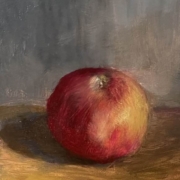 James Lee Stanley
James Lee Stanley

